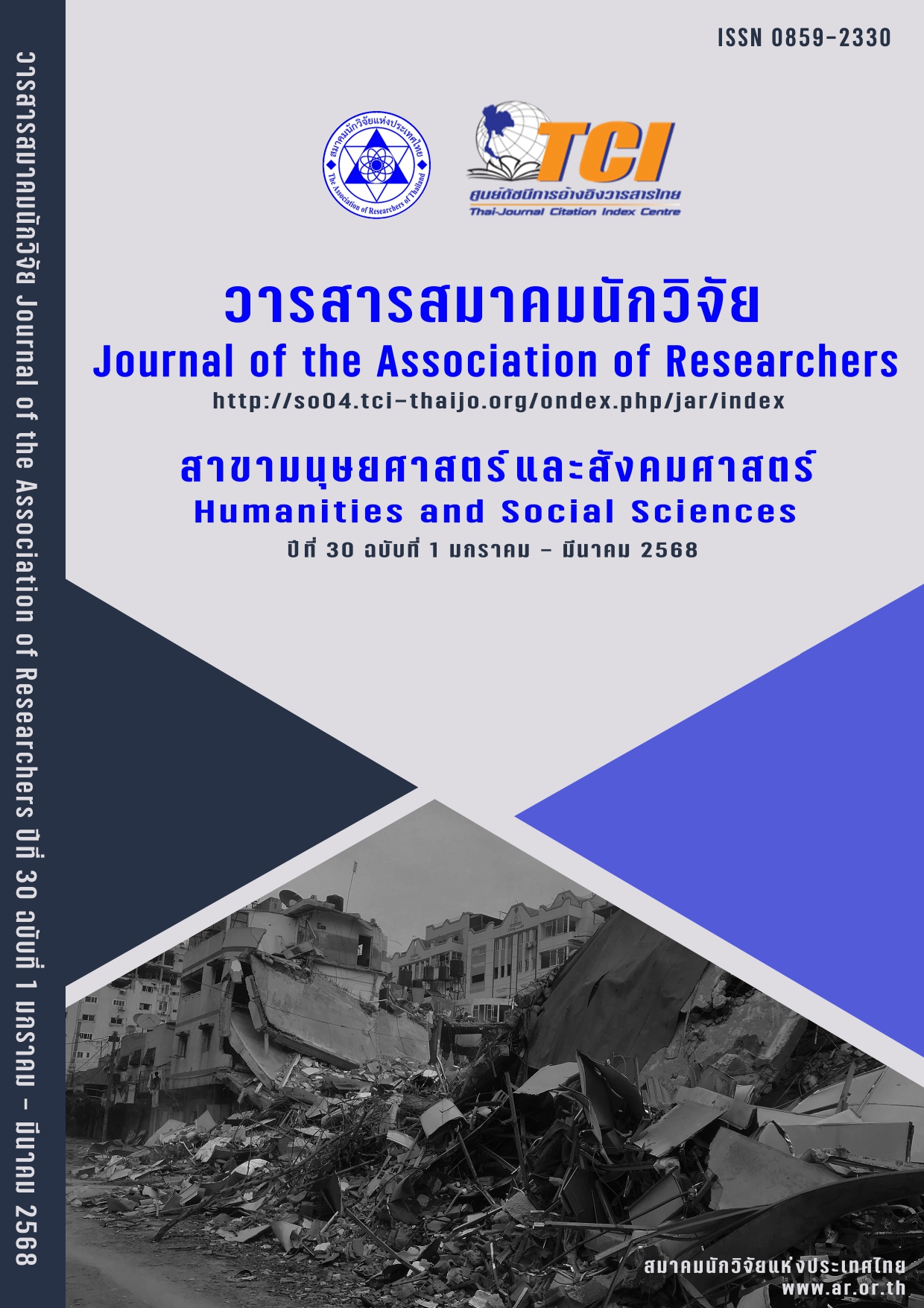Creative Economy Development of Hot spring for Healthy at Vichianburi District Phetchabun Province
Main Article Content
Abstract
The development of creative economy of hot springs for health in Wichian Buri District, Phetchabun Province still lacks a systematic and sustainable approach to promote the potential of hot springs as health tourism and creative economy that can attract tourists and create added value for local communities. This research aims to develop a creative economy approach for hot springs for health in Wichian Buri District, Phetchabun Province. Data were collected from in-depth interviews with entrepreneurs of Ban Kru Hot Spring, Wichian Buri District, Phetchabun Province, using unstructured interviews and using a satisfaction questionnaire on the use of services from 65 tourists. The research findings revealed that, despite having few competitors, a marketing problem exists because tourists are not highly interested in hot spring tourism. Most visits occur during festivals when tourists are passing through the area and searching for attractions online. Tourists visiting the hot springs primarily come during major festivals, which drive travel to Phetchabun Province. The approaches for promoting the hot spring business, based on the opinions of the operators, can be summarized as follows: There should be increased public relations efforts, especially promoting nearby tourist spots that are easily accessible. Service fees should be reasonably priced, not too expensive, and promotions should be offered during festivals to attract customers. Additionally, tours of nearby tourist attractions could be organized. Tourists of all genders and ages should be able to access and enjoy the services. Local authorities should be encouraged to promote health tourism in the area. The hot springs should also be developed into a learning center, with additional services such as Thai massage, foot massage, spa treatments, exercise facilities, and safe, convenient accommodations.
Article Details

This work is licensed under a Creative Commons Attribution-NonCommercial-NoDerivatives 4.0 International License.
บทความที่ปรากฏในวารสารนี้ เป็นความรับผิดชอบของผู้เขียน ซึ่งสมาคมนักวิจัยไม่จำเป็นต้องเห็นด้วยเสมอไป การนำเสนอผลงานวิจัยและบทความในวารสารนี้ไปเผยแพร่สามารถกระทำได้ โดยระบุแหล่งอ้างอิงจาก "วารสารสมาคมนักวิจัย"
References
กรมสนับสนุนบริการสุขภาพ. (2559). ยุทธศาสตร์การพัฒนาประเทศไทย ให้เป็นศูนย์กลางสุขภาพนานาชาติ (MEDICAL HUB) (พ.ศ.2560 - 2569). รายงานฉบับสมบูรณ์. กรมสนับสนุนบริการสุขภาพ กระทรวงสาธารณะสุข.
กรมการท่องเที่ยว กระทรวงการท่องเที่ยวและกีฬา. (2557). คู่มือการตรวจประเมินมาตรฐานคุณภาพแหล่งท่องเที่ยวเชิงสุขภาพ ประเภทน้ำพุร้อนธรรมชาติ. สำนักงานกิจการโรงพิมพ์องค์การสงเคราะห์ทหารผ่านศึกในพระบรมราชูปถัมภ์.
เกสสิณี ตรีพงศ์พันธุ์. (2563). แนวทางการพัฒนาน้ำพุร้อนคลองฉนวนสู่การเป็นแหล่งท่องเที่ยวเชิงสุขภาพในจังหวัดสุราษฎร์ธานี. วารสารวิทยาลัยดุสิตธานี, 14(2), 157–178.
ชุติมา นุตยะสกุล และ นรินทร์ สังข์รักษา. (2562). รูปแบบการพัฒนาบุคลากรในธุรกิจสปาเพื่อส่งเสริมการท่องเที่ยวเชิงสุขภาพ สำหรับนักท่องเที่ยวผู้สูงอายุ. วารสารวิทยาลัยดุสิตธานี, 13(3), 1–29.
ชนิษฐา ใจเป็ง และวิลาวรรณ พิศแสวง. (2565). ปัจจัยที่ส่งผลต่อพฤติกรรมการท่องเที่ยวเชิงสุขภาพ ของนักท่องเที่ยวผู้สูงอายุชาวไทย กรณีศึกษาน้ำพุร้อนสันกำแพง เชียงใหม่. วารสารวิชาการ มจร บุรีรัมย์, 104 – 118.
ธนพล แก้วสังข์, และคณะ. (2564). แนวทางการพัฒนาแหล่งท่องเที่ยวเชิงสุขภาพบ่อน้ำพุร้อนเค็ม อำเภอคลองท่อม จังหวัดกระบี่. วารสารศิลปะศาสตร์และอุตสาหกรรมบริการ, 4(2),133–140.
นฤมล รัตนไพจิตร, ราตรี เขียวรอด และ ตรีวนันท์ เนื่องอุทัย. (2561). ปัจจัยที่มีอิทธิพลต่อพฤติกรรมการท่องเที่ยวเชิงสุขภาพของผู้สูงอายุ จังหวัดนครศรีธรรมราช. รายงานการวิจัย คณะวิทยาศาสตร์และเทคโนโลยี มหาวิทยาลัยเทคโนโลยีราชมงคลศรีวิชัย.
บุษราภรณ์ กอบกิจพานิชผล และ ธีรพันธ์ ทัศนิยม. (2565). การวิเคราะห์โอกาสและแนวทางการพัฒนาศักยภาพการท่องเที่ยวเชิงสุขภาพประเภทน้ำพุร้อนธรรมชาติโดยชุมชนในจังหวัดเชียงใหม่ เพื่อรองรับการท่องเที่ยววิถีใหม่ (New Normal Tourism). มนุษยศาสตร์สาร, 23(2), 104–135.
วิคิเนีย มายอร์. (2555). การศึกษาแรงจูงใจการท่องเที่ยวและความพึงพอใจของนักท่องเที่ยวชาวไทยที่เดินทางมาท่องเที่ยวบ่อน้ำร้อนรักษะวารินและบ่อน้ำร้อนพรรั้ง จังหวัดระนอง. วิทยานิพนธ์ปริญญาโทสาขาวิชาการจัดการท่องเที่ยว คณะศิลปะศาสตร์และวิทยาศาสตร์ มหาวิทยาลัยธุรกิจบัณฑิตย์.
งามนิจ แสนนำพล และคณะ. (2563). สถานการณ์และศักยภาพของธุรกิจเชื่อมโยงการท่องเที่ยวรอบแหล่งท่องเที่ยว ประเภทน้ำพุร้อนในกลุ่มจังหวัดภาคเหนือตอนบน. วารสารสังคมศาสตร์วิชาการ, 13(1), 1-19.
Translates in Thai Reference
Department of Health Service Support. (2016). Strategic Plan for Developing Thailand as an International Medical Hub (2017-2026). Full Report. Department of Health Service Support, Ministry of Public Health. 30 pages. (in Thai)
Department of Tourism, Ministry of Tourism and Sports. (2014). Assessment Manual for Quality Standards of Health Tourism Destinations: Natural Hot Springs Category. The War Veterans Organization of Thailand Under Royal Patronage Printing Office.. (in Thai)
Kaeosang, T., et al. (2021). Guidelines for the Development of Salty Hot Springs Health Tourism Sites in Klong Thom District, Krabi Province. Guidelines for the Development of Salty Hot Springs Health Tourism Sites in Klong Thom District, Krabi Province. Journal of Liberal Arts and Service Industry, 4(2), 133–140. (in Thai)
Kobkitpanichpol, B., & Tadniyom, T. (2022). Analysis of Opportunities and Guidelines for Health Tourism Potential Development of Natural Hot Spring and Community-Based Tourism in Chiang Mai Province: Implementation for the New Normal for Tourism. Chiang Mai University Journal of Humanities, 23(2), 104–135. (in Thai)
Jaipen, C., & Pttsawang, W. (2022). Factor Affecting Health Tourism Behavior of Senior Thai Tourists Case Study of Sankamphaeng Hot Spring Chiangmai. Academic MCU Buriram Journal, 7(2), 104–118. (in Thai)
Nootayasakul, C., & Sungrugsa, N. (2020). Model of Human Resource Development in the Spa Business to Promote Wellness Tourism for Senior Tourists . Dusit Thani College Journal, 13(3), 16–29. (in Thai)
Rattanapaijit, N., et al. (2018). Factors Influencing the Elderly’s Health Tourism Behavior in Nakhon Si Thammarat Province. Final Report. Faculty of Science and Technology. Rajamangala University of Technology Srivijaya. 90 pages. (in Thai)
Mayor, W. (2012). A Study of Travel Motivation and Satisfaction of Thai Tourists Visiting Raksawarin Hot Spring and Pho Rang Hot Spring in Ranong Province. Master's Thesis, Tourism Management Program, Faculty of Arts and Sciences, Dhurakij Pundit University. 131 pages. (in Thai)
Saennampol, N., et al. (2020). The Situation and Potentiality of Related Tourism Business Surrounded Hot SpringsAttractions in the Upper Northern Provincial Cluster, Thailand. Journal of Social Academic, 13(1), 1-19. (in Thai)
Tripongpun, K. (2020). Developing in Klong Chanuan to Wellness Tourism in Surat-thani. Dusit Thani College Journal, 14(2), 157–178. (in Thai)


